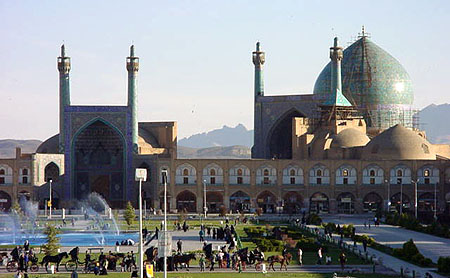HIS 112
Unit 4: South Asia and Gunpowder Empires

The Shah Mosque in Isfahan was built at the height of Safavid power in the seventeenth century, during the reign of the greatest of the Safavid monarchs, Shah Abbas I (1587-1629); currently a UNESCO world heritage site. Photo source was en.wikipedia.org/wiki/Image:Shah_Mosque_in_Esfahan.jpg.
 What you must do in this unit
What you must do in this unit
- Read the section in chapter 16 on the Ottoman Empire and chapter 20 in the textbook. There is not as much material in the textbook on Safavid Persia as I would have wished.
- Read my notes on South Asia and Gunpowder Empires, the Ottoman Empire and the Safavid Empire.
- Watch the short video by Professor Evans
- Check out Professor Campbell's video, Was The English East India Company B.S.?
- Study the Questions to Consider and the Key Terms for the unit.
- Think about your Digital Project assignment (150 points). Please check your course schedule for the exact due date and for the deadline for instructor approval of your project, and please read the details about the assignment now so that you are prepared as the due date approaches. Please submit your topic and type of project to your instructor for approval.
For students majoring in criminal justice, I have some ideas/suggestions for this assignment that you might consider.
- Post (or respond) with your thoughts/ideas/comments about this unit's reading in the discussion board in Canvas: What were some of the common features of the gunpowder empires (5 points)?
What you can do in this unit
- Watch the online lecture by Professor Sheda Vasseghi, NVCC, on the Safavid Empire.
- Check out the timeline on the early Mughal emperors created by Tayyaba Azeem, student.
- Often within the course, you will find an extra credit option to answer study questions on the unit's reading (see below for the link to the Chardin study questions). Your answers to study questions should not be simple yes/no answers, but they should be thorough answers. Here is a link to an example of outstanding study question answers done by one of the students in HIS 112.
Some videos that you can watch for this unit
Extra Credit Options
- For up to 50 points of extra credit, read John Chardin, Travels in Persia, 1673-1677 and then submit the Chardin paper.
- For up to 10 points of extra credit, read The Status of Jews
and Christians in Muslim Lands (1772) and in a long paragraph comment upon the nature of Muslim-Jewish-Christian relations in the eighteenth century.
- For up to 10 points of extra credit, read François Bernier, An Account of India and the Great Moghul,
1655, and write a long paragraph in which you explain Shah Jehan's style of rule.
- For up to 5 points of extra credit,
you can submit the answers to the Chardin study questions. Please write in formal, complete sentences.
- For extra credit, please suggest a
relevant website for this unit of the course. Send your instructor the title of the site, the URL and a brief explanation why you find the information interesting and applicable to the material being studied this unit.
Unit Learning Objectives
- Upon successful completion of this unit, you will be able to (1) describe the development of the Near East and South Asia under imperial control in the seventeenth century, (2) appreciate the cultural achievements of these three Muslim empires (Ottoman, Mughul and Safavid) and (3) manipulate selected online, digital tools to create a mini-history research project.
|